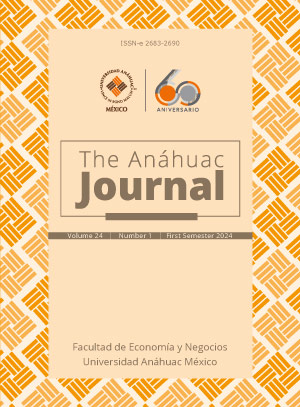Comparación del desempeño de arquitecturas de memoria a corto y largo plazo (LSTM) en el pronóstico de precios de acciones: una investigación sobre el mercado bursátil mexicano
Contenido principal del artículo
Resumen
Este trabajo compara el desempeño de la memoria de corto y largo plazo (LSTM, por sus siglas en inglés) univariada y multivariada en la predicción de los precios de cierre del día siguiente de cuatro acciones del sector de consumo minorista en la Bolsa Mexicana de Valores. El error absoluto medio (MAE, por sus siglas en inglés), el error porcentual absoluto medio (MAPE, por sus siglas en inglés), la mediana del error porcentual absoluto (MdAPE, por sus siglas en inglés) y la raíz del error cuadrático medio (RMSE, por sus siglas en inglés) se utilizan para probar el desempeño de las redes. Por un lado, los resultados muestran un mejor desempeño en el pronóstico multivariado de precios cuando se utilizan secuencias de 20 y 15 días de duración, generando resultados coherentes para la muestra, incluidas las acciones líquidas e ilíquidas. Por otro lado, la LSTM univariada revela un desempeño de pronóstico menor para la predicción del precio de acciones ilíquidas.
Downloads
Detalles del artículo
Sección

Esta obra está bajo una licencia internacional Creative Commons Atribución-NoComercial-CompartirIgual 4.0.
The Anáhuac Journal se distribuye bajo Licencia Creative Commons Atribución-NoComercial-CompartirIgual 4.0 Internacional.
Cómo citar
Referencias
Andi, H. (2021). An accurate bitcoin price prediction using logistic regression with LSTM machine learning model. Journal of Soft Computing Paradigm, 3(3), 205–217. https://doi.org/10.36548/jscp.2021.3.006 DOI: https://doi.org/10.36548/jscp.2021.3.006
Armitage, S., Brzeszczyński, J. & Serdyuk, A. (2014). Liquidity measures and cost of trading in an illiquid market. Journal of Emerging Market Finance, 13(2), 15–5196. https://doi.org/10.1177/0972652714541340 DOI: https://doi.org/10.1177/0972652714541340
Benchaji, I., Douzi, S. & Ouahidi, B. E. (2021a). Credit card fraud detection model based on lstm recurrent neural networks. Journal of Advances in Information Technology, 12(2), 113–118. https://doi.org/10.12720/jait.12.2.113-118 DOI: https://doi.org/10.12720/jait.12.2.113-118
Benchaji, I., Douzi, S., Ouahidi, B. E. & Jaafari, J. (2021b). Enhanced credit card fraud detection based on attention mechanism and lstm deep model. Journal of Big Data, 8(1), 1–21. https://doi.org/10.1186/s40537-021-00541-8 DOI: https://doi.org/10.1186/s40537-021-00541-8
Bhandari, H. N., Rimal, B., Pokhrel, N. R., Rimal, R., Dahal, K. R. & Khatri, R. K. (2022). Predicting stock market index using LSTM. Machine Learning with Applications, 9, article 100320. https://doi.org/10.1016/j.mlwa.2022.100320 DOI: https://doi.org/10.1016/j.mlwa.2022.100320
Ghosh, A., Bose, S., Maji, G., Debnath, N. & Sen, S. (2019). Stock Price Prediction Using LSTM on Indian Market Share. International Conference on Computer Applications in Industry and Engineering, 63, 101–110. https://doi.org/10.29007/qgcz DOI: https://doi.org/10.29007/qgcz
Haykin, S. (2010). Neural Networks and Learning Machines. Pearson Education India.
Krenker, A., Bešter, J. & Kos, A. (2011). Introduction to the Artificial Neural Networks. In K. Suzuki (Ed.), Artificial Neural Networks: Methodological Advances and Biomedical Applications. InTech. https://doi.org/10.5772/15751 DOI: https://doi.org/10.5772/15751
Landazuri Aguilera, Y. & Ruíz Pérez, R. (2021). El desempeño del sector productos de consumo frecuente en época de pandemia. Memorias del Coloquio Nacional de Investigación en las Ciencias Económicas y Administrativas, 114–132. https://shorturl.at/eEX78
Liebergen, B. V. (2017). Machine learning: a revolution in risk management and compliance? Journal of Financial Transformation, 45, 60–67. https://www.capco.com/Capco-Institute/Journal-45-Transformation
Lu, Y. (2017). Deep neural networks and fraud detection [Master’s thesis], Uppsala University. https://shorturl.at/ozEGI
Nielsen, M. (2015). Neural networks and deep learning. Determination Press, 25, 15–24. http://neuralnetworksanddeeplearning.com/
Nourbakhsh, Z., & Habibi, N. (2023). Combining LSTM and CNN methods and fundamental analysis for stock price trend prediction. Multimedia Tools and Applications, 82,17769–17799. https://doi.org/10.1007/s11042-022-13963-0 DOI: https://doi.org/10.1007/s11042-022-13963-0
Pramod, B. & Mallikarjuna, S. P. (2020). Stock Price Prediction Using LSTM. Test Engineering and Management, 83, 5246-5251. https://shorturl.at/bjtA2
Tianxiang, Y. & Zihan, W. (2020). Crude oil price prediction based on LSTM network and GM (1,1) model. Grey Systems: Theory and Application, 11(1), 80–94. https://doi.org/10.1108/GS-03-2020-0031 DOI: https://doi.org/10.1108/GS-03-2020-0031
Tirozzi, B., Puca, S., Pittalis, S., Bruschi, A., Morucci, S., Ferraro, E. & Corsini, S. (2007). Neural networks and sea time series: reconstruction and extreme-event analysis. Springer Science & Business Media. https://doi.org/10.1007/0-8176-4459-8 DOI: https://doi.org/10.1007/0-8176-4459-8
Wiese, B. & Omlin, C. (2009). Credit card transactions, fraud detection, and machine learning: Modelling time with LSTM recurrent neural networks. In Bianchini, M., Maggini, M., Scarselli, F. & Jain, L.C. (Eds.), Innovations in neural information paradigms and applications. Springer, 231-238. https://doi.org/10.1007/978-3-642-04003-0_10 DOI: https://doi.org/10.1007/978-3-642-04003-0_10
Yu, Y., X. S., Hu, C. & Zhang, J. (2019). A review of recurrent neural networks: Lstm cells and network architectures. Neural Computation, 31(7),1235–1270. https://doi.org/10.1162/neco_a_01199 DOI: https://doi.org/10.1162/neco_a_01199
Zaheer, S., Anjum, N., Hussain, S., Algarni, A., Iqbal, J., Bourouis, S. & Ullah, S. (2023). Multi Parameter Forecasting for Stock Time Series Data Using LSTM and Deep Learning Model. Mathematics, 11(3), 590. https://doi.org/10.3390/math11030590 DOI: https://doi.org/10.3390/math11030590

